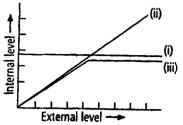A bird introduced from another country became a serious pest due to:
1. Better adaptation to new area
2. More sexual reproduction
3. Better nesting habitats
4. Absence of natural competition
Through resource partitioning:
1. Two species can compete for the same prey
2. Slight variation in niche allow closely related species to co-exist in the same habitat
3. Competitive exclusion results in the success of the superior species
4. Two species undergo character displacement that allows them to compete
The figure given below is a diagrammatic representation of response of organisms to abiotic factors. What do (i), (ii) and (iii) represent respectively?
| (i) | (ii) | (iii) | |
| (1) | Conformer | Regulator | Partial regulator |
| (2) | Regulator | Partial | Conformer regulator |
| (3) | Partial | Regulator | Conformer regulator |
| (4) | Regulator | Conformer | Partial regulator |
When the value of 'r' is significantly low as compared to another species, it is better known by:
(1) Competition exclusion
(2) Interference competition
(3) Resource partition
(4) Competitive release
The four levels of biological organization to which Ecology is basically concerned are:
1. Macromolecules-tissues-populations-biome
2. Macromolecules-organisms-population-biome
3. Tissues-organs-community-biome
4. Organisms-Populations-Community-Biome
Physiological ecology
1. works at the organismic level
2. Tries to understand the adaptation with respect to survival only
3. Tries to understand the adaptation with respect to reproduction only
4. None of these
A wide variety of habitats within a biome can be a result of
1. Regional variation of temperature and precipitation.
2. Local variation of temperature and precipitation
3. Both 1 and 2
4. Natural selection
| A. | Life exists in compost pits, permafrost polar regions. |
| B. | Our intestine host only 3-10 microbes. |
| C. | Major biomes of India include desert rainforest and tundra. |
| D. | The important physicochemical components alone characterise different habitats. |
How many of the above statements is/are wrong?
1. Three
2. Two
3. Only one
4. All four
Which of the following is best suited with the abiotic factor temperature, playing role in changes in the physicochemical environment of different habitats?
1. The average temperature of land is approximately 50 throughout the year
2. The temperature of temperate countries is very much favorable for mango trees
3. Temperature affects the kinetics of enzyme and hence the basal metabolic activity of the body
4. Both 1 and 2
Aquatic organisms face problems when water quality gets disturbed. Here water quality includes
1. Chemical composition, temperature, pH
2. Chemical composition and pH
3. Only pH
4. pH and temperature







